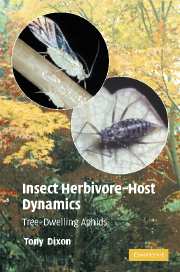Book contents
- Frontmatter
- Contents
- Preface
- 1 Introduction
- 2 Tree-dwelling aphids
- 3 Trees as a habitat: relations of aphids to trees
- 4 Trees as a habitat: relations of aphids to their natural enemies
- 5 Carrying capacity of trees
- 6 Aphid abundance
- 7 Population dynamics
- 8 Risky dispersal
- 9 Seasonal sex allocation
- 10 Aphids and tree fitness
- 11 Rarity, conservation and global warming
- Epilogue
- References
- Species index
- Subject index
7 - Population dynamics
Published online by Cambridge University Press: 08 August 2009
- Frontmatter
- Contents
- Preface
- 1 Introduction
- 2 Tree-dwelling aphids
- 3 Trees as a habitat: relations of aphids to trees
- 4 Trees as a habitat: relations of aphids to their natural enemies
- 5 Carrying capacity of trees
- 6 Aphid abundance
- 7 Population dynamics
- 8 Risky dispersal
- 9 Seasonal sex allocation
- 10 Aphids and tree fitness
- 11 Rarity, conservation and global warming
- Epilogue
- References
- Species index
- Subject index
Summary
In spite of natural enemy-inflicted mortality initially being regarded as the most likely factor regulating tree aphid abundance this notion lacks empirical support. However, there is a lot of support for the idea that the abundance of tree-dwelling aphids is regulated by intraspecific competition (Chapter 6). Here an in-depth study of two population censuses is used to account for the different population patterns observed in two species of aphids, and more general population models presented, which incorporate the effect of cumulative density (Chapter 6) and seasonal changes in carrying capacity (Chapter 5), and both these factors. Finally, the data in the literature on other deciduous and coniferous tree-dwelling aphids is reviewed to determine the generality of regulation by intraspecific competition and the ‘seesaw’ effect – high numbers in spring followed by low numbers in autumn and vice versa.
PATTERNS IN POPULATION DYNAMICS
The studies on tree-dwelling aphids have revealed strong direct density-dependent recruitment and dispersal, and an inverse relationship between the numbers of aphids hatching from eggs in spring and the numbers present several generations later in autumn (Dixon, 1970c, 1971c, e; pp. 84–6). This delayed response is referred to as the ‘seesaw’ effect. The results of a more detailed analysis of two data sets are presented: the sycamore aphid Drepanosiphum platanoidis population census collected in Glasgow from 1960 to 1973 and that for the Turkey oak aphid Myzocallis boerneri, in Norwich from 1975 to 1995.
- Type
- Chapter
- Information
- Insect Herbivore-Host DynamicsTree-Dwelling Aphids, pp. 93 - 121Publisher: Cambridge University PressPrint publication year: 2005



